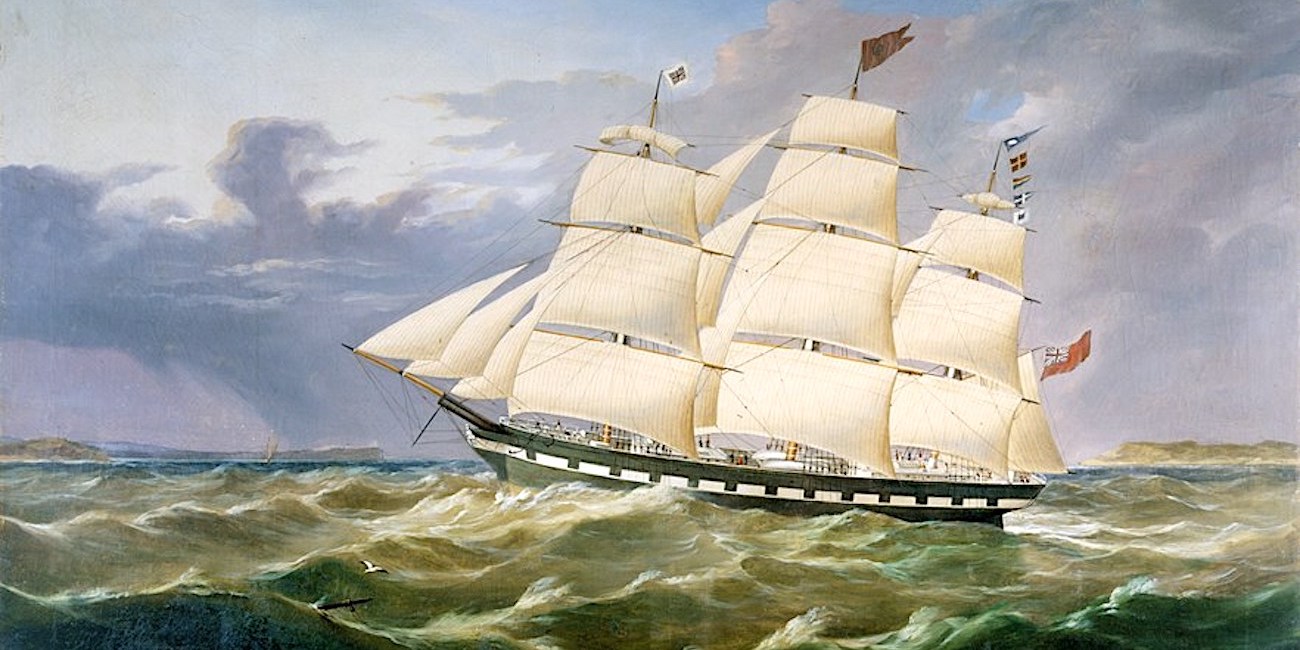Emigration
Charles boarded the clipper Catherine Adamson in London on 5 November 1856, sailing for Australia. The ship carried cargo, diverse as clothing and spring bulbs, as well as 30 crew and 13 passengers. He arrived in Sydney after a sea voyage of almost 3 months, on 24 January 1857.
 |
| Clipper Marco Polo, 1859, similar to the Catherine Adamson. |
The Catherine Adamson made her maiden voyage the year before. Built for speed, she was one of the fastest making the journey, covering over 300 miles a day. For a period, she held the record from Sydney to Plymouth in 69 days. Charles emigrated on the Catherine Adamson's second voyage.
The clipper didn't survive beyond her third voyage. In October 1857, the Catherine Adamson sank when returning to Sydney. She dropped anchor off North Head. Overnight, heavy seas dragged her onto the rocks. The storm smashed the lifeboats against the side of the ship.
Most of the occupants drowned. By 8am that morning, the clipper had completely broken up. Cargo and bodies littered the shores of North Harbour. Part of the cargo was a large amount of wine, ale, rum, brandy and other spirits. In a scene like the film Whisky Galore!, the locals 'salvaged' much of the alcohol.
Charles settled in Wagga Wagga, New South Wales, a village of under 600 residents. He worked for Forsyth & Co, a general store opened in 1855.
Gold rush
New South Wales experienced the first Australian gold rush from 1851 to 1880. There was a rapid expansion of population and a significant boost to the economy. The colonial government found traces of gold as early as 1823. They suppressed the news, concerned about the effect on small communities. The Californian gold rush in 1848 saw many leave Australia to seek their fortunes. To stem the exodus, the government encouraged the search for gold in the colony. In 1852, prospectors found over 24 tons of gold.
During the next 20 years, the population of Wagga Wagga grew from 600 to 3,000. New stores and hotels opened. Charles was ambitious, keen to profit from the opportunities of a growing town. In 1869, he went into partnership with Denis Bergin and Henry Moxham. To great fanfare, they opened the Wagga Wagga Store, selling general goods and saddlery.
 |
| Wagga Wagga Store opening, the 3 partners at the entrance. |
In 1871, Charles married Eliza Shaw at Wagga Wagga. Eliza was born in Melbourne. She was 19 years of age, Charles 38 years. They had ten children, four of whom died in infancy.
Copthorn's Palace Emporium
The partnership with Bergin and Moxham lasted until 1872. On 25 April 1873, Charles opened the Wagga Wagga Drapery Store. To a great fanfare, he announced the delivery of new stock weighing 5 tons. Regular adverts appeared in local newspapers announcing the latest imported goods from England.
.jpeg) |
| Fitzmaurice St, Wagga Wagga, c1875. Charles Corthorn's shop is visible on the left. |
Charles also engaged in local politics. In 1879 became an alderman. Gas lighting arrived at the shop in 1881. As business boomed, Charles kept extending the premises. He placed an article advertising the opening of Corthorn's Palace Emporium. An 1884 article that Charles probably wrote himself detailed how the business was expanding.
Charles diversified. He invested in the Rangatira and Tarcutta Gold Mines, both within a day's ride. Prospectors found gold at both mines. Unfortunately, the volume did not cover expenses and the investors' money ran out.
In 1884, Charles applied for a licence. He planned to build a Commercial Hotel at Junee, 26 miles from Wagga Wagga. Gold was found locally, and an important railway line had opened nearby. But competition was stiff. In 1887, Charles sold the Commercial Hotel and three adjoining leased shops.
Overstretched
Selling drapery was second nature to Charles. But not the finance side. The strain of tending to the shop and the finances of the business took its toll. Charles placed a notice in the local newspaper giving debtors a final warning. If they didn't pay their accounts up promptly, he would sue them. In August 1887, Charles took on Robert MacVine as his partner in the Palace Emporium. Robert had been Charles' accountant for the previous four years.
In September 1887 there were rumours the Palace Emporium was to close. The pair published an offer of £10 reward for information leading to the successful prosecution of whoever was circulating the rumours. They dissolved the partnership by April 1888, Charles back in sole control.
Charles advertised the sale of his stock at any reasonable price in September 1888. He planned to leave the district. Shortly after, Charles sold the Palace Emporium 'at enormous reduction' to J G Bourne & Co. The Palace Emporium was still trading in the 1920s.
Charles auctioned all his belongings and household effects in Nov 1888. Although supposedly retiring from business, he continued work as a valuer and agent. He and Frances also took in boarders at 28 Nicholson Street, Balmaine, on the outskirts of Sydney.
Bankruptcy
In November 1895, Charles declared himself bankrupt. He gave the causes as the sickness of his wife, losing boarders and a lack of employment.
Charles died in July 1910 at Richmond, Lavender Bay, Sydney, aged 77 years. He is buried at Gore Hill cemetery. Wagga Wagga residents still called his former Palace Emporium Charles Corthorn's shop in 1912, long after he'd gone.
To read more about St Ivians who settled worldwide, click Emigrants.


No comments:
Post a Comment